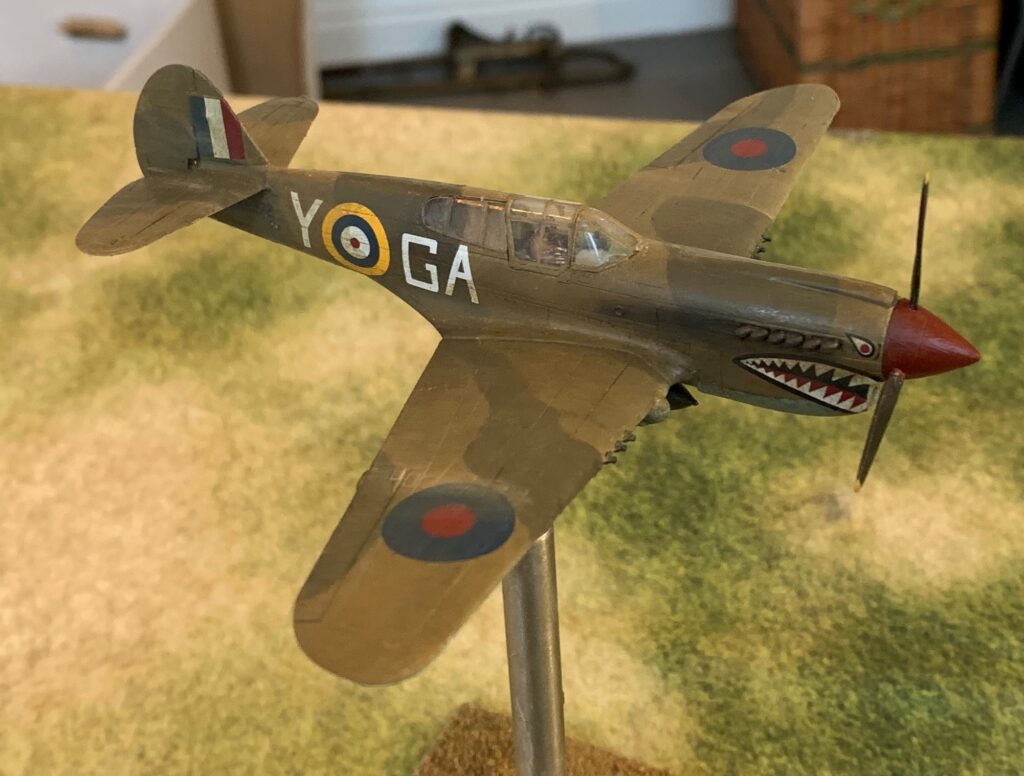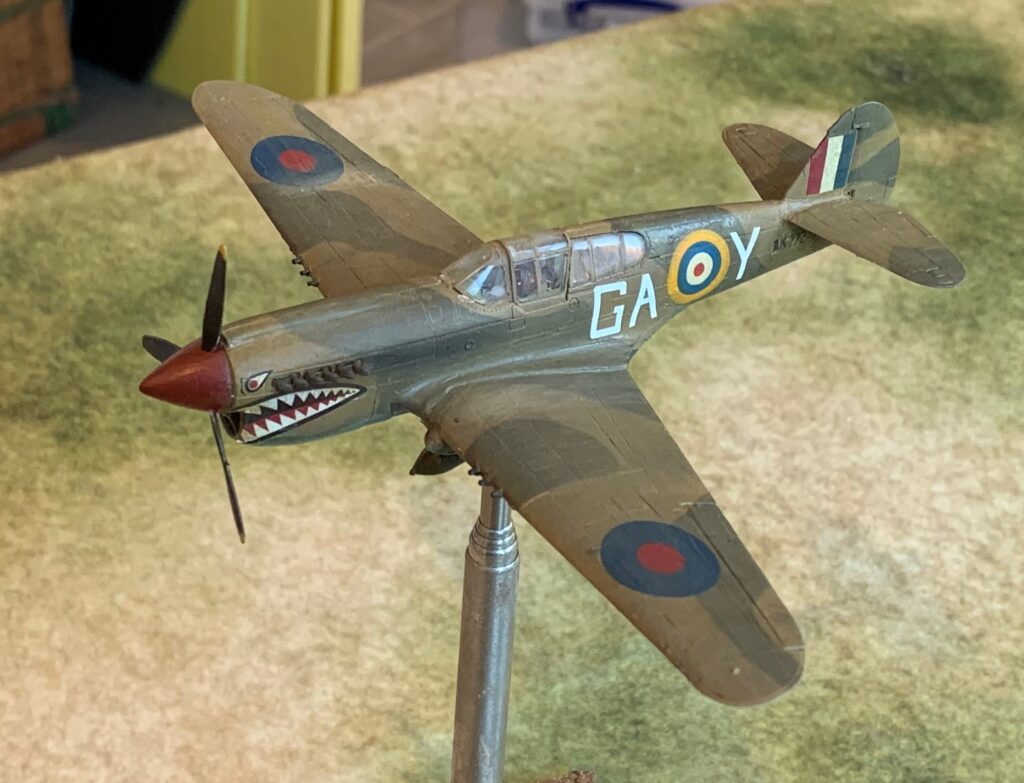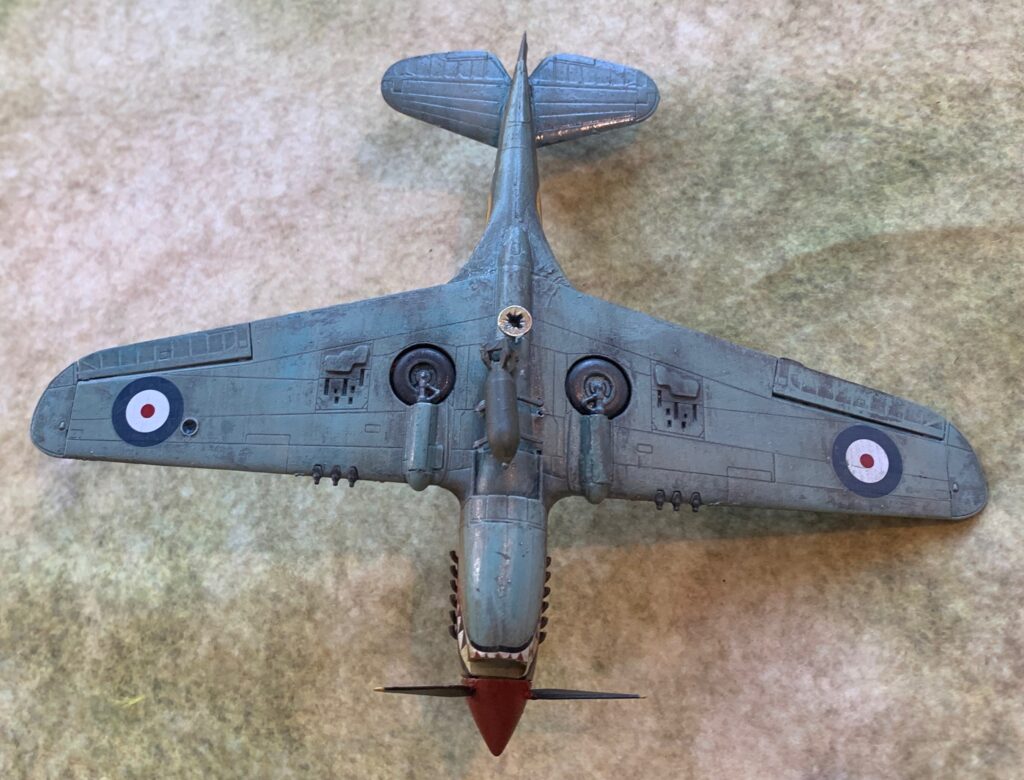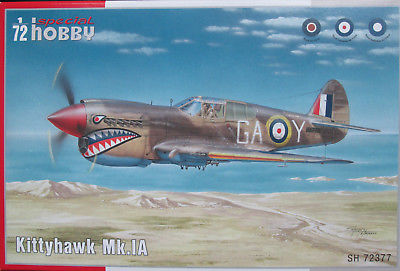Next a look at my Kittyhawk. The P-40, later models of which became the RAF Kittyhawk (earlier ones were called Tomahawk by the RAF), played an important role in the RAF efforts in the Mediterranean. At first they were used to supplement the Hurricanes as air-superiority fighters – as the former were outclassed by the arrival of the Messerschmitt Bf 109F – plus it was easier to ship them direct from the US to Egypt than supply from the UK. Then as the Spitfires took on that role, they were used primarily as fighter-bombers. By 1943 they had become the RAF’s principal fighter-bomber, increasingly supplemented by Spitfires Vs, as the Luftwaffe retreated and the Spitfire VIIIs and IXs came into play.
The P-40 isn’t the most elegant of aircraft (US designers rarely did elegant, unlike their British and, less often, German counterparts). But it was robust and highly functional (which the US designers were unbeatable at, except maybe by the Russians), and especially suitable for this theatre and the fighter-bomber role. It was let down by its Allison engine, which performed well at low altitude, but not at the higher altitudes needed for escort and other mainline fighter roles. By 1943 the P-40F and L (RAF Kittyhawk IIs) were powered by Merlin engines – which did much better at altitude. Americans using these models as fighter escorts against Bf-109Gs got perfectly respectable results, especially as by this time the US pilots were better trained and rested than their opponents. But the Merlins were needed elsewhere – notably for Mustangs, a far better air-superiority machine – and the later Allison engines were fine for fighter-bombers, so later P-40s (the K, M and N) went back to these.
At the start of my project, in autumn 2020, I went on a buying spree for my models, anxious to beat full Brexit, which kicked in in January 2021. I chose this model from Special Hobby of the Kittyhawk IA to be my Kittyhawk. Alas for my research. The Kittyhawk 1A was the P-40E, which was obsolete by 1943, being replaced by the Kittyhawk II (the P-40F or L) or, mainly, III (the K or M – and apparently some of the Ls, though presumably re-engined). The later versions were chiefly distinguished by a lengthened fuselage, which set the tail back a bit from the tailplanes. I discovered my mistake quickly enough, but decided to press ahead. I decided to do the plane on the box art from 112 Squadron, with its distinctive shark’s teeth. This is a bit hackneyed and overexposed in artwork – other squadrons did not have these markings. But they really do work well on the P-40, so I thought I’d do it anyway. The plane is marked GA-Y, is from 1942, and was lost in May of that year. For some reason it has been by far the most popular to be portrayed on model aircraft. Here is a picture of it:

The Special Hobby kit proved to be a lovely one, in spite of being on the usual undercarriage down mode. The undercarriage doors fitted neatly into the recesses – the only problem is that one of them was very small, and I managed to lose it. This is the mark of a good quality, professionally-made model. The PJ pilot got in without too much trouble but it is a roomy cockpit compared to the Hurricane or Spitfire – or the Bf 109 or Fw-190 come to that. The only awkward bit was fitting the fuselage assembly onto the wing assembly. For some reason this often seems to be a problem (it was the case on both the other models too). I needed to be a bit more patient, and the fit isn’t quite right. Anyway, here is the result:



I used the US bomb from the kit – the RAF did use these (and the US used British bombs). It’s a bit skew though. Also the bomb dips a bit, probably because I didn’t get the pylons right. I have seen pictures of centrally mounted bombs dipping on Spitfires – but that doesn’t show on the picture above. I might try to correct this. I have already commented the errors on paint colours. Also the cockpit canopy suffered from some excess glue. The biggest problem was with the decals. Unfortunately the GAOY on the port side got displaced, as did the starboard serial number – and this escaped my final checks an so dried out of place. I decided that I could correct the worst of this by replacing the roundel (even though it wouldn’t then match the position on the other side). As I was searching stock for a new roundel, I found the decals for my original Airfix Kittyhawk kit from the 1970s. They were for the same aircraft. The big letters were a bit heavier than the Special Hobby ones (which are more realistic anyway), so I decided only to replace the roundel – though I needed to overpaint the yellow to hide a pale outer circle. The GA remains slightly skew. I was also able to replace the serial number, though the Airfix ones were also a bit heavy. The port serial in the kit has a dark background (which looks like an unsuccessful intervention from the censors!) – which is there in the original photo. I didn’t like this so I was happy to replace the serial on this side too.
And so there it is! Another 1942 model in dodgy colours. This can do service on the table, but I’m minded to do a Kittyhawk III as well. I’m also looking at a P-40L in US service, as flown by the Tuskegee Airmen, which would also have RAF camouflage colours.
